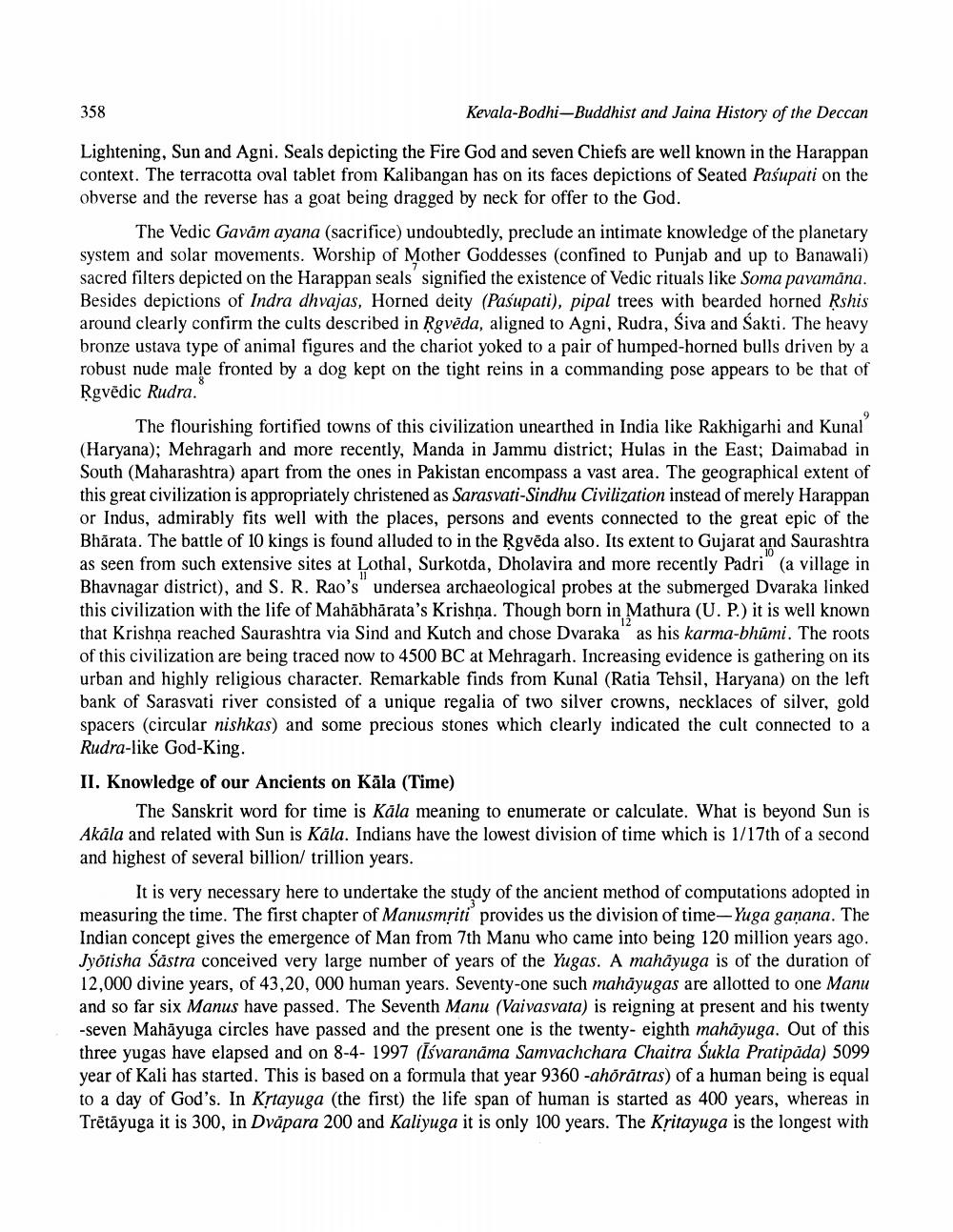________________
Kevala-Bodhi-Buddhist and Jaina History of the Deccan
Lightening, Sun and Agni. Seals depicting the Fire God and seven Chiefs are well known in the Harappan context. The terracotta oval tablet from Kalibangan has on its faces depictions of Seated Pasupati on the obverse and the reverse has a goat being dragged by neck for offer to the God.
358
The Vedic Gavám ayana (sacrifice) undoubtedly, preclude an intimate knowledge of the planetary system and solar movements. Worship of Mother Goddesses (confined to Punjab and up to Banawali) sacred filters depicted on the Harappan seals signified the existence of Vedic rituals like Soma pavamāna. Besides depictions of Indra dhvajas, Horned deity (Pasupati), pipal trees with bearded horned Rshis around clearly confirm the cults described in Rgveda, aligned to Agni, Rudra, Śiva and Sakti. The heavy bronze ustava type of animal figures and the chariot yoked to a pair of humped-horned bulls driven by a robust nude male fronted by a dog kept on the tight reins in a commanding pose appears to be that of Rgvédic Rudra.
The flourishing fortified towns of this civilization unearthed in India like Rakhigarhi and Kunal (Haryana); Mehragarh and more recently, Manda in Jammu district; Hulas in the East; Daimabad in South (Maharashtra) apart from the ones in Pakistan encompass a vast area. The geographical extent of this great civilization is appropriately christened as Sarasvati-Sindhu Civilization instead of merely Harappan or Indus, admirably fits well with the places, persons and events connected to the great epic of the Bharata. The battle of 10 kings is found alluded to in the Ṛgvēda also. Its extent to Gujarat and Saurashtra as seen from such extensive sites at Lothal, Surkotda, Dholavira and more recently Padri (a village in Bhavnagar district), and S. R. Rao's" undersea archaeological probes at the submerged Dvaraka linked this civilization with the life of Mahabhārata's Krishṇa. Though born in Mathura (U. P.) it is well known that Krishna reached Saurashtra via Sind and Kutch and chose Dvaraka" as his karma-bhūmi. The roots of this civilization are being traced now to 4500 BC at Mehragarh. Increasing evidence is gathering on its urban and highly religious character. Remarkable finds from Kunal (Ratia Tehsil, Haryana) on the left bank of Sarasvati river consisted of a unique regalia of two silver crowns, necklaces of silver, gold spacers (circular nishkas) and some precious stones which clearly indicated the cult connected to a Rudra-like God-King.
12
II. Knowledge of our Ancients on Kala (Time)
The Sanskrit word for time is Kāla meaning to enumerate or calculate. What is beyond Sun is Akala and related with Sun is Kāla. Indians have the lowest division of time which is 1/17th of a second and highest of several billion/ trillion years.
It is very necessary here to undertake the study of the ancient method of computations adopted in measuring the time. The first chapter of Manusmriti provides us the division of time-Yuga ganana. The Indian concept gives the emergence of Man from 7th Manu who came into being 120 million years ago. Jyotisha Sastra conceived very large number of years of the Yugas. A mahayuga is of the duration of 12,000 divine years, of 43,20, 000 human years. Seventy-one such mahāyugas are allotted to one Manu and so far six Manus have passed. The Seventh Manu (Vaivasvata) is reigning at present and his twenty -seven Mahayuga circles have passed and the present one is the twenty-eighth mahayuga. Out of this three yugas have elapsed and on 8-4- 1997 (Isvaranama Samvachchara Chaitra Sukla Pratipada) 5099 year of Kali has started. This is based on a formula that year 9360 -ahōrátras) of a human being is equal to a day of God's. In Krtayuga (the first) the life span of human is started as 400 years, whereas in Trêtayuga it is 300, in Dvdpara 200 and Kaliyuga it is only 100 years. The Kritayuga is the longest with




